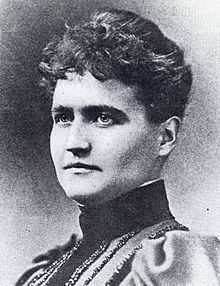Eliza Ruhamah Scidmore
| Eliza Ruhamah Scidmore | |
|---|---|
 | |
| Born |
October 14, 1856 Clinton, Iowa, USA |
| Died |
November 3, 1928 (aged 72) Geneva, Switzerland |
| Nationality | American |
| Occupation | Author |
| Known for |
writing on Asian topics, early proponent of planting Japanese cherry trees in Washington, D.C. |
Eliza Ruhamah Scidmore (pronounced SID-more)[1] (1856–1928) was an American writer, photographer and geographer, who became the first female board member of the National Geographic Society.[2] She visited Japan many times between 1885 and 1928.
Scidmore was born October 14, 1856 in Clinton, Iowa. She attended Oberlin College. Her interest in travel was aided by her brother, George Hawthorne Scidmore, a career diplomat who served in the Far East from 1884 to 1922. Eliza was often able to accompany her brother on assignments and his diplomatic position gave her entree into regions inaccessible to ordinary travelers.
It was on their return to Washington, D.C. in 1885 that Eliza had her famous idea of planting Japanese cherry trees in the capital. Scidmore found little interest in her cherry tree idea, but more in her impressions of Alaska, the subject of her first book, Alaska, Its Southern Coast and the Sitkan Archipelago (1885). She joined the National Geographic Society in 1890, soon after its founding, and became a regular correspondent and later the Society's first female trustee.
Further eastern travels resulted in Jinrikisha Days in Japan, published in 1891. It was followed by a short guidebook, Westward to the Far East (1892). A trip to Java resulted in Java, the Garden of the East (1897) and visits to China and India resulted in several National Geographic Magazine articles and two books, China, the Long-Lived Empire (1900), and Winter India (1903).
Another stay in Japan during the Russo-Japanese War became the basis for Scidmore's only known work of fiction, As the Hague Ordains (1907). The novel purports to be the account of a Russian prisoner's wife who joins her husband at the prisoner's hospital in Matsuyama.
Scidmore's cherry blossom scheme began to bear fruit when incoming first lady Helen Taft took an interest in the idea in 1909. With the first lady's active support, plans moved quickly, but the first effort had to be aborted due to concerns about infestation. Subsequent efforts proved successful, however, and today many visitors enjoy the sakura of West Potomac Park and other areas of the capital, particularly during the National Cherry Blossom Festival.
After As the Hague Ordains, Scidmore published no new books and a dwindling number of articles for National Geographic, the last being a 1914 article entitled "Young Japan." She died in Geneva on November 3, 1928, at the age of 72.
References
- ↑ Michael E. Ruane, "Cherry blossoms’ champion, Eliza Scidmore, led a life of adventure," Washington Post, March 13, 2012.
- ↑ Mauzé, Marie; Harkin, Michael Eugene; Kan, Sergei (2004). Coming to Shore: Northwest Coast Ethnology, Traditions, and Visions. University of Nebraska Press. p. 206. ISBN 0-8032-3230-6. Retrieved 26 January 2014.
- Place of birth from passport applications April 1, 1878, June 27, 1894 and September 28, 1903 also passenger list from Yokohama to Seattle July 1923. Her family was living in Clinton, Iowa in the 1856 Iowa Census, taken earlier in the year of her birth.
- Eliza Ruhamah Scidmore: More Than A Footnote In History by Daniel Howard Sidmore M.A.L.S. Benedictine University Lisle, Illinois Thesis Approval May 2000
External links
- Eliza Scidmore Biography Site
- New Research on Eliza Scidmore
- Works by or about Eliza Ruhamah Scidmore in libraries (WorldCat catalog)
- Works by Eliza Ruhamah Scidmore at Internet Archive
|